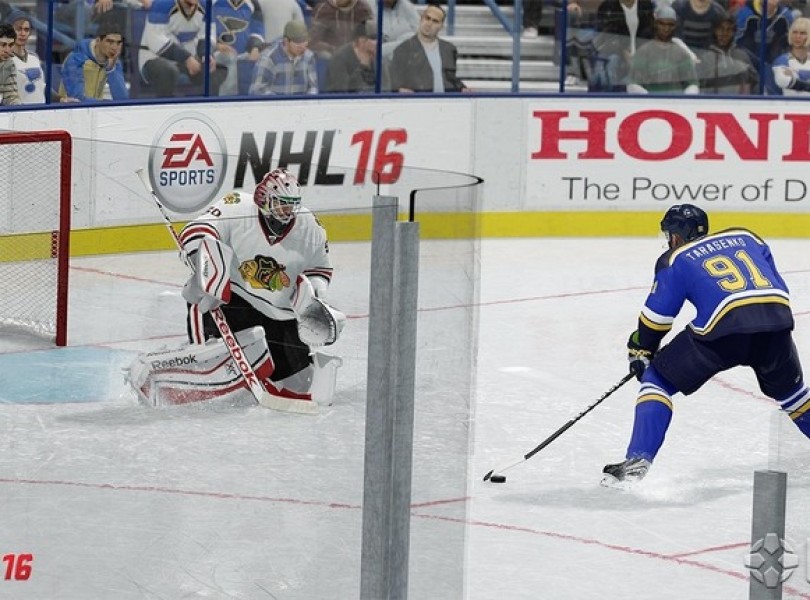More bang for your puck.
By Seth G. Macy
After last year’s disappointingly shallow NHL 15, it warms my heart to see NHL 16 make major strides toward a comeback. Salvaging the previous game’s already strong and exciting fundamental hockey simulation and great looks and combining them with tons of expansive modes for both long-time fans and newcomers, this year is a return to form in the most important ways, other than its still-unreliable online play.
Replays are almost indistinguishable from broadcast hockey.
The hockey game presented here has all the speed, hits, and excitement of the real deal. The action on the ice is fast and fluid, and the controls feel responsive and accurate. Spotting a hole in the defense and exploiting it for a goal never failed to lift me off my seat, fist-pumping like a crazy person. The whole thing looks and feels so much like the real thing that replays are almost indistinguishable from broadcasts, with scratches on the ice, reflections on players’ helmets, and team mascots whipping the virtual crowds into a frenzy all working wonderfully to put me in the game. However, as real as it looks, there are times when the framerate simply chugs; thankfully that’s usually limited to off-ice intros and fan reactions, but it’s really jarring given how good everything on the ice looks.
Most of those good looks and underlying gameplay carries over from NHL 15, which is a pretty hockey game with very little to extend its appeal beyond one-off games. This time, the list of modes and play options available in NHL 16 makes it feel like a worthy successor to the hockey games of years past. Modes like Season Mode, EA Sports Hockey League, and Online Team play have returned, and there’s a lot of fun to be had in taking your hometown team from the season opener all the way through to the playoffs.


Advertisement
Advertisement
Advertisement
Advertisement
Advertisement
Advertisement
Of course, the hockey season is long – one of the longest in professional sports – so if you don’t feel like putting in the time to play an entire season, jumping right into playoff mode is also an option. You can play (or simulate) your way to the Stanley Cup without needing to play the staggering 82 games in the regular season. For me, the only reason I’d want to skip games would be to avoid having to hear the same repetitious Doc Emrick, Eddie Olczyk, and Ray Ferraro commentating lines over and over again.
Hockey Ultimate Team is back, and this year you can play a single-player season with your pros.
There are still missing modes (I can’t help but miss the great NHL ‘94 mode that was apparently a one-time anniversary thing for NHL 14) and features (no custom soundtrack?) but improvements to returning modes help take the sting out it. For instance, Hockey Ultimate Team is back, and this year you can play a single-player season with your pros. That means you can adjust and practice crafting your team over a season before letting it loose in online play or playing against a friend.
However, NHL 16 has also done something sports games tend to overlook: it goes out of its way to accommodate newcomers to the series and introduce them to its intimidating control language that long-time series fans take for granted. Not only has practice mode returned to a form that can be considered useful (its predecessor had pared it down to just a skater-versus-goalie mode) but its other addition, the On-Ice Trainer, has made NHL 16 into something anyone with familiarity with a controller can pick up and begin to play.
On-Ice Trainer really helps make sense of NHL 16’s shooting system.
Turning on the On-Ice Trainer puts control suggestions above the head of the player you’re controlling. When it’s semi-transparent, the trainer is giving you a suggestion on what you should be preparing to do; when the suggestion is fully opaque, that’s the trainer telling you to check or pass or shoot right now. And there are visual cues built in to help you understand where your pass or shot will land. A smart system is in place for teaching you to make shots: a matrix appears in the net, showing you what parts of the goal are open for the puck, and what parts are blocked by the goalie. Aiming with the left stick, you can get a feel for where and how to shoot to maximize your potential for goals. It really helps make sense of NHL 16’s shooting system.
Helping further are the tips shown between periods and after every game. You’re given a grade based on how well you’ve performed on the ice, and the “coach” gives you tips and advice. But at the same time, it could be more helpful with its constructive criticism. For instance, I was chided for losing faceoffs and the suggestion was for me to adopt a backhand grip without actually telling me how to do that.
But whether you know how to play EA’s hockey games already or not, NHL 16’s main weakness is its online play. I played during the EA Access weekend on Xbox One, and on PS4 with a handful of other players, (both on a hard-wired connection to my modem) and I was unable to play an entire game on either platform without some sort of disruptive lag or stutter. Online Shoot-Out mode was similarly frustrating, because while match-finding and connection times were admirable, the connection issues were so bad that I could never confidently tell you if I scored due to my skill or because my opponent saw my avatar deke when I was actually shooting. With so many modes in NHL 16 being online enabled, this really presents a problem if you don’t have another hockey fan next to you.
When played by yourself or with a friend on the couch, NHL 16 is a fast, sharp-looking, and fun hockey sim that (unlike last year’s game) includes enough modes to keep veterans happy while doing an admirable job of welcoming newcomers as well. It still suffers technical problems with online play, which is a shame, because outside of noticeably repetitious play-by-play calling and some non-gameplay-affecting framerate issues in cutscenes and replays, NHL 16 is an otherwise excellent game.



